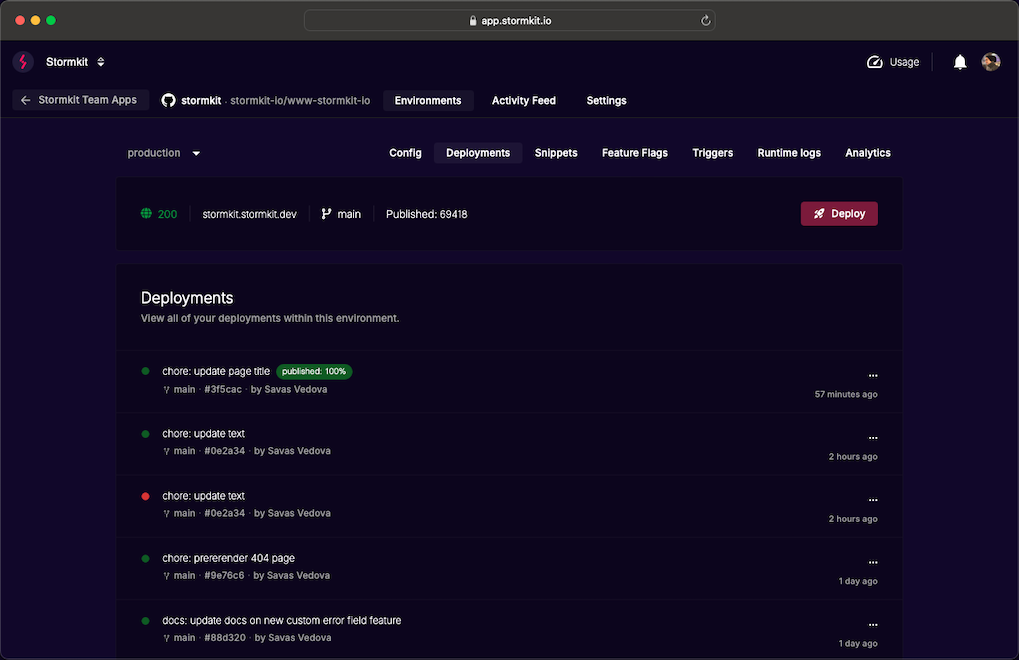What makes Stormkit a
great Vercel alternative
Stormkit is an intuitive, scalable, and cost-effective self-hostable platform for frontend applications. It comes with built-in features like deployment previews, analytics, snippet injections, multiple environments and more.
Vercel, on the other hand, is a fully-managed cloud provider in the same space. This article goes through the reasons of why may want to consider Stormkit as an alternative to Vercel.

1. Self-Hostability vs. Managed Service
- One of the most significant differences between Stormkit and Vercel lies in the hosting approach: Stormkit is self-hostable. This means you have the option to deploy Stormkit on your own infrastructure, providing you with complete control over your environment. Whether you're looking to deploy on-premises or within your private cloud, Stormkit gives you flexibility in how and where your applications are hosted. This approach is ideal for enterprises with specific security or compliance requirements, allowing full control over data residency, networking, and scaling.
- Vercel, on the other hand, is a fully managed service. You don't need to worry about managing the underlying infrastructure; Vercel takes care of everything for you. This makes Vercel an excellent choice for developers who prioritize convenience and simplicity, allowing them to focus solely on coding and application performance without handling the complexities of server management.
Watch the following tutorial on how to install Stormkit on an Ubuntu Server and deploy a Next.js Application within a few minutes.
2. Deployment Flexibility
- When self-hosting Stormkit, developers can deploy their frontend applications in multiple ways, whether via GitHub Actions, custom servers, or other CI/CD platforms. This approach empowers teams by allowing them to choose the best solution that fits their enterprise.
- Vercel excels in automatic deployments thanks to their vast infrastructure and tools. Vercel owns Next.js, which also allows them tailoring the framework according to their infrastructure design. This, in return, gives especially Next.js developers a great development experience.
3. Customizability and Control
- Stormkit shines when it comes to customizability. Because Stormkit is self-hostable, you have complete control over your deployments, server configurations, and infrastructure. This makes it ideal for complex use cases where fine-tuning is required, such as deploying applications in hybrid environments, or scaling based on your exact needs. Stormkit also integrates seamlessly with existing infrastructure, whether it's AWS, Google Cloud, or a private data center.
- Vercel provides a more opinionated stack. While it is easy to use, you are limited to Vercel's infrastructure and configurations. Customizations such as scaling, server configurations, or special networking requirements might be limited, as Vercel abstracts much of the underlying infrastructure away from the user. It is designed for simplicity and speed but may not be the best fit for more complex or enterprise-level projects requiring a high degree of control.
4. Pricing Transparency and Predictability
- Stormkit offers transparent and predictable pricing. With its clear pricing tiers, you know exactly what you're paying for upfront, with no hidden costs or add-ons. This can be particularly advantageous for teams who want to avoid unexpected overage charges and ensure that their hosting costs remain predictable month to month. You can check our pricing here.
- Vercel also offers a variety of pricing tiers, from free to enterprise-level plans. However, like many managed services, there can be additional costs as you scale up, particularly if your app requires advanced features, more bandwidth, or premium performance. While the free tier is generous, larger projects may find the pricing less predictable as usage grows.
4. Vendor Lock-In
- Stormkit is designed with no vendor lock-in in mind. Because it is self-hostable, you can deploy it on your own infrastructure, switch hosting providers, or move to a completely different cloud with ease. This flexibility ensures that you aren't locked into a single provider and can retain control of your environment.
- Vercel is a managed service, which inherently comes with some level of vendor lock-in. Since Vercel handles everything from deployment to hosting and CDN, migrating to another provider could require reworking your deployment pipeline and infrastructure.
Conclusion
- Both Stormkit and Vercel offer powerful solutions for frontend hosting, but they cater to different needs: Stormkit is best for developers and teams who value flexibility, control, and customizability. Its self-hostable nature makes it ideal for projects with specific infrastructure requirements, such as enterprise applications or companies that want to avoid vendor lock-in.
- Vercel excels at offering a simple, managed experience with a seamless workflow for modern development teams. It's great for those who prioritize ease of use and want to focus solely on building and deploying without dealing with the complexities of infrastructure management.
- Ultimately, the choice between Stormkit and Vercel depends on your project's needs. If you want maximum control over your hosting environment, Stormkit is the way to go. If you prefer a fully managed solution with minimal setup, Vercel might be a better fit.
What's Next?
Check our documentation to get started with self-hosting.